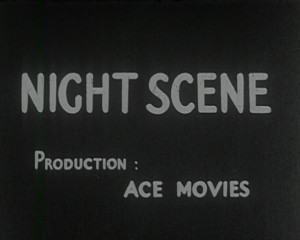
"London's West End by night. Street life and theatrical exteriors. Three couples (Kae Lomas and Ben Carleton, Phyllis Robertson and Keith Hodder, Frieda Hale and Geoffrey Collyer) meet and have varied reactions. For the first couple it is idyllic. The second couple experience friction. The third couple spend the evening apart! Features neon-lit facades of Alhambra, Capitol and His Majesty's Theatre and everyone smoking" (EAFA Database).
"only our second film – but good enough to be picked from among the whole of the entry in The Era Contest of 1932 to represent Great Britain in the International Contest, in which it took second prize… The film, which was but 180 feet in length, was an attempt to portray pictorially the workings of an unhinged mind; a subject, you will agree, that no professional could possibly exploit. The production was, maybe, a trifle crude – I would be the last to deny it – but at least the theme was original" (Mellor 1933: 102).
"Photographed against the variegated background of Japanese life In Southern California, "Nisei Parade" strives to follow the lives of three nisei youths and of a girl, the sister of one of them, who returns to California after attending school in Nippon. The two young men, Ikuo and Sueo Serisawa, have taken their camera and their script into every phase of Japanese life into America. The story is centered on Jiro, one of the three nisei who is employed in one of the many huge produce markets in Southern California, and who is torn between the choice of a career as a photographer necessitating years of study, and his love for Sumi, the girl. It is the story also of George and Shig, the other two youths. The roles are capably portrayed by Tadashi Kamayatsu, Alice Iserl, Peter Takahashi, and James Sujishi. Although taken on 16mm. stock, and although it is a silent, film utilizing Japanese and English titles, "Nisei Parade" won praise for its photographic excellence when shown before various American groups, including MGM." The New World Daily News, March 14, 1935, 1.
"J. R. Derisowa [sic] received honorable mention for his 2000-ft. picture, 'Nisei Parade'. As a general rule it is difficult to maintain interest through five reels of pictures." American Cinematographer, Feb. 1936, 73.
"a war film… deals principally with submarines… an almost full-sized submarine was built out of sheet-iron and wood; the very convincing interior of the aforesaid submarine was built in a garage; and merchant ships (models) were ruthlessly blown up by a torpedo (ditto, bought at Woolworths), which zipped through the water (by a string wound on a Kodak rewind) and left a wicked-looking wash (milk)" (R.S. 1932: 9).
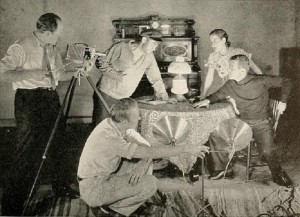
"Not One Word, by Kenneth F. Space, ACL, is an all around triumph of amateur photoplay production. It is a simple melodrama of the keeper of a lighthouse, his wife and the rejected suitor who returns. A wreck at sea (beautifully staged in miniature) is the complicating dramatic factor, and, with these ingredients, a dignified motion picture story of remarkable unity has been produced. In it, Mr. Space and his able staff have blended dramatic lighting, authentic settings and superb photography to achieve a distinguished whole. Under restrained but smoothly paced direction, the three leading players have enacted their roles with definite histrionic skill. If one were to try to select a single quality in the film which is outstandingly brilliant, the vote of this observer would be cast for the cutting. It is accurate and incisive, adding that last bit of dramatic "punch" which is perhaps the quality least often achieved by the amateur producer. Not One Word speaks for itself, but in the wordless and potent idiom of cinematic imagination." Movie Makers, Dec. 1934, 534.
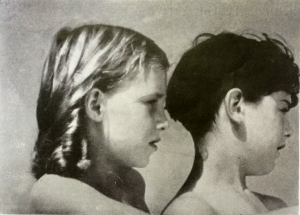
"a soggetto"/fiction
"Nuvola - Nuvola soggetto e regia di P. M. Pasinetti e Roberto Zerboni, fotografia di Francesco Cerchio, interpretato da due bambini, Giorgio Balboni e Liliana della Valle. Un cane e il solo altro personaggio della vicenda, e il film si vale di po-chi altri elementi per comporre il suo dramma: una barca, i cerchi, un fiore; e sopratutti iI sole e il mare: sia la vicenda che la sua trattazione si mantengono in un tono leggermente favoloso, che rimanda per certi aspetti a quel mondo che e proprio delle composizioni liriche di Roberto Zerboni, di cui anche noi abbiamo pubblicati vari esempi, e che sono seguite con moltissima attenzione dai bene informati. In senso cinematografico, la pellicola rispetta sempre una sobrietà di stile singolarmente accurata, e si vale quasi esclusivamente del sistema delle inquadrature fisse, studiando piuttosto la composizione e l'armonia del quadro, e mai cedendo alla retorica degli scorci o del montaggio inutilmente concitato, propria di varie produzioni sperimentali.”
"Cloud - Nuvola (Cloud), subject and direction by P. M. Pasinetti and Roberto Zerboni, photography by Francesco Cerchio, stars two children, Giorgio Balboni and Liliana della Valle. A dog is the only other character in the story, and the film makes use of a few other elements to compose its drama: a boat, circles, a flower, and above all the sun and the sea: both the event and its treatment are maintained in a slightly fabulous tone, which refers in some respects to that world that is proper to the lyrical compositions of Roberto Zerboni, of which we have published several examples, and which are followed with great attention by the well-informed. In the cinematographic sense, the film always respects a singularly accurate sobriety of style, and makes use almost exclusively of the system of fixed shots, studying rather the composition and harmony of the picture, but never yielding to the rhetoric of the foreshortening or of the uselessly excited editing, typical of various experimental productions.”
— Il ventuno 24 (Review of the G.U.F. of Venice) January 1935, p. 15
"Tales of doomed and thwarted love are timeless, and this intriguing short film relates a story set in Imperial China. Told to a young couple planning their wedding and marital home, they - and we - learn the tragic tale of Koong-Shee and Chang, her father's servant, as revealed in the traditional pattern on a Willow pattern plate. George Wain, one of the filmmakers, plays the role of the fiancé." (BFI Player)
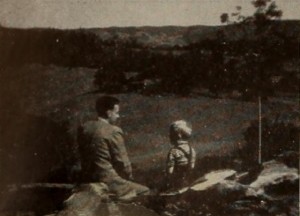
"Five years before the action of The Old House opens, a young man and his bride of but a year had been involved in a train wreck. The bride, Claire, was killed: but the man — scarred in mind, bruised in body and (he thought) dependent on a walking stick — lived on. He comes now, as the film begins, for one last look at the Old House, "the Old House where I was born and grew up, where Claire and I had been so happy for one short year, with hopes and plans for a future that never came." But, instead of viewing (with self-inflicted sadness) his old homestead, he meets accidentally with a brightfaced boy of five, son of his widowed tenant. How this youngster, this "artless wisdom dressed in blue jeans," frees the man from his stick (a mere surface symbol of his bondage) and from his obsession with the past is the theme of The Old House. But it is fruitless always to attempt a factual outline of any visual study in human relations. And, heartwarmingly, believably and triumphantly, The Old House is simply and exactly that. The producer, Keith Hall, has plotted the course of his tenuous drama with a sure touch and unfailing taste. His scenic progressions are so artful as to seem artless, while his camera work and narrative exposition never fail him in the delicate unfolding of his denouement. Yet it is to the three players of this picture — and to their narrator — that the ultimate tributes must be paid. Young Ross Hall as the Boy, Noela Hall as his widowed Mother, and Mr. Hall himself as the Man are exactly and exquisitely right in their restrained underplaying of three diflicult roles. Reg Cameron, the narrator, speaks lines which are always literate, and often lyric, with warmth and understanding. From its simple opening to its quietly soaring climax, The Old House is a tender and moving triumph." Movie Makers, Dec. 1953, 318-319.
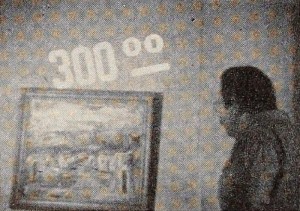
"In Paintings, George E. Canning has hung his story on a simple plot that serves to display an artist's works. A lady makes an appointment with the artist with the intent of making a purchase. The artist, beset by a pile of bills, wonders what he should charge or hope to get; and here figures expressing his thoughts are cleverly superimposed on the scenes of action. The paintings are interesting in themselves for their variety of subject matter and style (this fact rather belies the artist's penury), and the interior lighting throughout the film is excellent. The artist (John S. Arhorn) is well played by himself, the lady by Julia Canning. One could wish that the plot's denouement is not so readily anticipated." Movie Makers, Dec. 1952, 340.
Passionflower is a Finnish entry by Matti Sokka of Helsinki, another "aftermath of the war" story about a widow and her emotional trials. It is in color and its 8 minutes tries to picture the futility of those who are left behind. Unusual camera angles, a little different story approach and exceptionally good exposure took this film out of the run-of-the-mill war story category," PSA Journal, Mar. 1970, 44.
Total Pages: 12